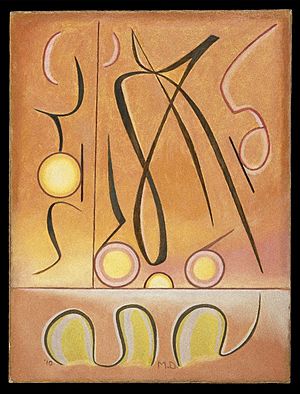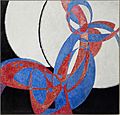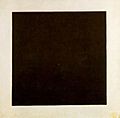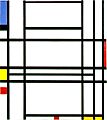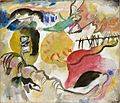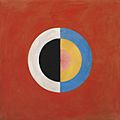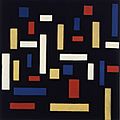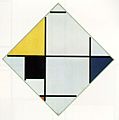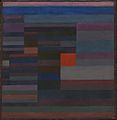Abstract art facts for kids
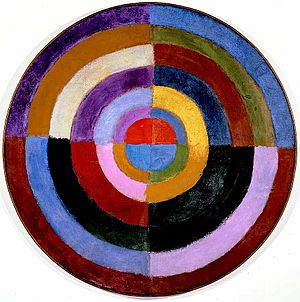
Abstract art is a type of modern art that doesn't show pictures of things we see in our everyday world. Instead, it uses colors, lines, and shapes to create images. These shapes and colors aren't meant to look like real objects or living things. Artists who create abstract art are often inspired by ideas about abstraction.
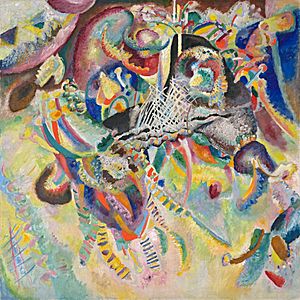
You can find abstract art in paintings and sculptures. Some artworks are a mix, being partly abstract and partly showing real things. Many artists create both abstract art and other kinds of modern art.
Pure abstract art was invented in the 1900s. It developed from earlier modern art styles. However, it's unique because it doesn't really have roots in older art forms like other styles do.
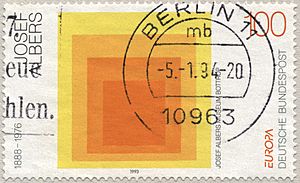
Contents
When Did Abstract Art Begin?
Early Abstract Artists
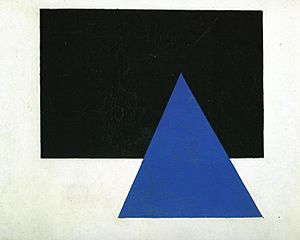
One of the first artists to make completely abstract paintings was Kazimir Malevich. In 1913, he showed a painting that was just a black square. He was part of a group called the Suprematists. Their art used simple geometric shapes. Art based on geometry is known as geometric abstraction.
Wassily Kandinsky also painted a famous abstract work called Composition VII in 1913. It was very complex and completely abstract.
An interesting story is about Manierre Dawson, an American artist from Chicago. While traveling in Europe in 1910, he started painting truly abstract works. When he returned to the United States, he decided he couldn't make a living as an artist and became a farmer. His work was forgotten until it was rediscovered in 1963. He might have been the very first person to paint a completely abstract artwork.
Many other artists have created abstract works. Piet Mondrian and the sculptor Henry Moore are two important artists who influenced many others.
What is Abstract Expressionism?
Art After World War II
After World War II, abstract art became very popular in the United States. Many amazing artists emerged during this time. Some were immigrants like Mondrian, Max Ernst, and Mark Rothko. Others were American-born, such as Barnett Newman and Jackson Pollock. These artists became very well-known.
Abstract expressionism is the name for the art movement that started after World War II. It was the first American art movement to become famous all over the world. This made New York City the new center for art in the western world, taking over from Paris. The term "abstract expressionism" was first used in 1919. However, it is mostly used to describe American art from the 1940s to the 1960s. The Russian artist Wassily Kandinsky is also considered an abstract expressionist.
How Abstract Expressionism Started
An important art style that came before abstract expressionism was surrealism. Surrealism focused on dreams and creating art without thinking too much, almost automatically. This idea influenced abstract expressionists. For example, Jackson Pollock would drip paint onto a canvas laid on the floor. This method used spontaneity and focused on:
- Action: The way the artist moved and worked.
- Automatism and the unconscious: The overall work might be planned, but the small details were not.
As art critic Harold Rosenberg said, "At a certain moment, the canvas began to appear to one American painter after another as an arena in which to act. What was to go on the canvas was not a picture but an event."
Abstract expressionist paintings often share some features. Artists used very large canvases. They also used an "all-over" approach. This means the entire canvas was treated with equal importance. In older art, the center of the painting was usually the most important part.
Key Facts About Abstract Expressionism
The Royal Academy suggests five important things to know about abstract expressionism:
- It came from a special time: Artists living in New York City in the 1940s shared many experiences.
- It used huge sizes: The artworks were often very, very large.
- It involved the viewer: Some people felt like they were part of the art.
- It broke old rules: For example, the art had an "all-over" look instead of one main focus point.
- Artists were connected but unique: Even though they were close, each artist had their own special style.
Types of Abstract Expressionism
Action Painting
Paintings by artists like Jackson Pollock show the actual movements and actions of the painter.
Color Field Painting
Color field paintings mostly feature large, flat areas of color, often in simple geometric shapes. Famous artists in this style include Mark Rothko, Barnett Newman, and Josef Albers.
Interesting Facts About Abstract Art
- Abstract art became popular in the 1900s, especially in New York.
- It does not show real things.
- It uses colors, lines, and shapes to express feelings and ideas.
- Abstract artworks are often very large.
- In abstract art, lines and figures are everywhere. Your eye doesn't focus on just one spot, unlike in traditional art.
- You can usually tell who painted an abstract piece by their unique style.
Images for kids
-
A hilya, a decorated description of Muhammad’s physical appearance, dating to the 19th century.
-
František Kupka, Amorpha, Fugue en deux couleurs (Fugue in Two Colors), 1912.
-
Kazimir Malevich, Black Square, 1923.
-
Kurt Schwitters, Das Undbild, 1919.
-
A 1939–1942 painting by Piet Mondrian titled Composition No. 10.
-
Albert Gleizes, 1910–1912, Les Arbres (The Trees).
-
Arthur Dove, 1911–12, Based on Leaf Forms and Spaces.
-
Francis Picabia, 1912, Tarentelle.
-
Wassily Kandinsky, 1912, Improvisation 27 (Garden of Love II).
-
Pablo Picasso, 1913–14, Head (Tête).
-
Henri Matisse, 1914, French Window at Collioure.
-
Hilma af Klint, Svanen (The Swan), 1914–1915.
-
Theo van Doesburg, Neo-Plasticism: 1917, Composition VII (The Three Graces).
-
Fernand Léger 1919, The Railway Crossing.
-
Albert Gleizes, 1921, Composition bleu et jaune (Composition jaune).
-
Piet Mondrian, Composition with Yellow, Black, Blue, Red, and Gray, 1921.
-
Paul Klee, Fire in the Evening, 1929.
-
Barnett Newman, Onement 1, 1948.
See Also
 In Spanish: Arte abstracto para niños
In Spanish: Arte abstracto para niños


